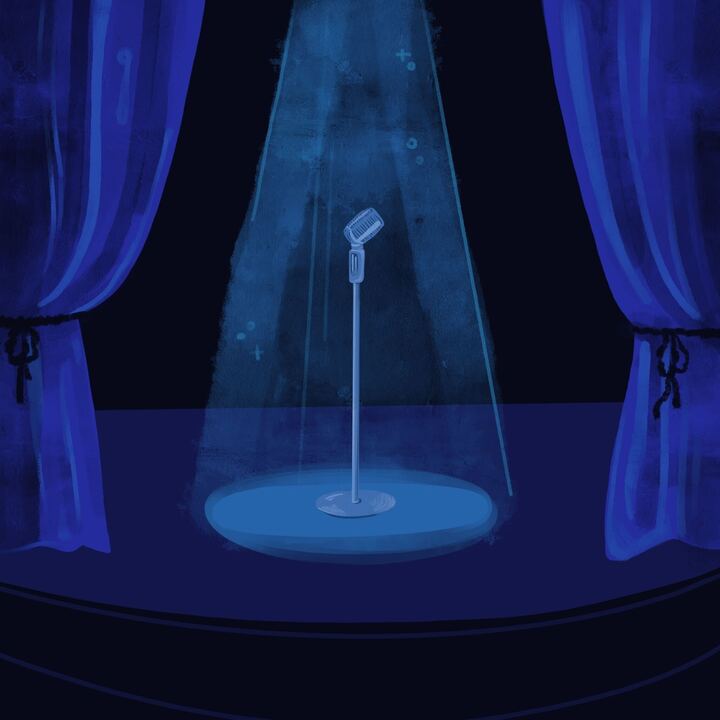Scene
‘In the Blue Light’ Album Review

Dion Hines | Senior Forum Editor
My first time hearing Kelela’s voice was during one of my routine bike rides the summer before eighth grade. Solange’s “A Seat at the Table” had been my obsession for the months prior, and — besides Lil Wayne’s feature on “Mad” and Q-Tip’s fluttery arrangement of “Borderline” — Kelela’s backing vocals on “Scales” had taken up an unhealthy amount of space in my mind. Surprisingly, though, I didn’t have my next known interaction with Kelela’s music until Feb. 9, 2024, when the alternative-R&B singer released “RAVE:N, The Remixes,” a 20-track techno-inspired reinterpretation of her second studio album, “Raven.”
Already having been a fan of tech-queenies like FKA Twigs and Shygirl, and more soulful artists like Ravyn Lanae and SZA, “RAVE:N” left me slack-jawed, and something less than conscious. The work was a compelling blend of rap and electronica-infused tracks, and jazz and soul-influenced vocals, a sound that the singer has seemingly perfected during her 12-or-so years of being in the music industry.
Her most recent album, “In the Blue Light,” released on Feb. 11 of this year, left me in a similar trance, though this time more in admiration than sedation. Performed and recorded at the famous Blue Note Jazz Club in New York City — which has featured greats such as Cannonball Adderley, Donald Byrd, and Geri Allen — “In the Blue Light” is an assortment of 12 reimagined tracks from her current discography. The album does a beautiful job of not only establishing Kelela’s versatility as an artist, but also her undeniable prowess as both a vocalist and lyricist.
The atmosphere of the album is established immediately; upon pressing play, I was introduced to the clanking of cutlery and shifting of seats of the Blue Note’s intimate setting. Kelela’s first arrangement, “Enemy,” was both the perfect complement to this environment and a dreamy transition into the jazzy landscape that the singer cultivates throughout her performance. The song explores the disappointment from a mediocre partner and the forgiveness that follows through dancing harps and chimes layered over droning vocals to create a lullaby of, “Shhh…just cry…then sleep.” The accompanying snaps and chatter from the audience unintentionally enhance the layers of the track. Then, Kelela’s voice forces itself into the scene, almost as an interjection: “You’re all up on me now that you’re my enemy / There’s nothing here to save, it’s all here in front of me,” she cries. The singer follows this song with “Raven,” a synthy ballad about the clarity that comes after a draining relationship.
This track, like the one that precedes it, appears to be Kelela’s attempt at self-soothing, which is necessary considering the emotional disaster that the singer describes in “Take Me Apart,” as she croons, “Don’t say you’re in love, baby / Don’t say you’re in love until you learn to take me apart.” It is in this song, along with others on the album such as “All the Way Down” and, my personal favorite, “Better,” that I was reminded of the gut-wrenching, painfully poetic lyricism that drew me into Kelela’s music in the first place. She rejects emotional unavailability, forcing the listener through the same tumultuous ups and downs that the singer experiences viscerally. The jazzy interpretation and gospel undertones of her originally electronic songs amplifies the melodramatic elements that Kelela incorporates into her music.
Speaking of jazz, during her set, Kelela shouts out her influences from the genre, which include Amel Larrieux (who Kelela saw perform at the Blue Note herself) and the late Betty Carter. These influences — along with possible others, namely Sarah Vaughn — become increasingly obvious in songs like “30 Years,” “Cherry Coffee,” and her covers of Betty Carter’s “Love Notes” and Joni Mitchell’s “Furry Sings the Blues.” I found these covers especially riveting due to Kelela’s ability to synthesize her influences’ sound and her own. The theatrical enunciation employed by Mitchell and Carter, in their respective works, is toned down to properly accompany the Janet Jackson-inspired groove and falsetto. Yet, the inspiration is not completely lost, allowing Kelela to maintain the integrity of the original works — including the folksy chords of Mitchell’s hit and droning delivery of Carter’s (I understand that sentiment is gravely overused. Just let me have it).
In summary, the album is absolutely amazing. It’s a breathtaking homage to Kelela’s jazz-filled background and a display of her passion for her craft. Kelela uses this album as an opportunity to simply fall, and we would be doing the artist a disservice not to fall alongside her. You have to listen to the album. You just HAVE to.
